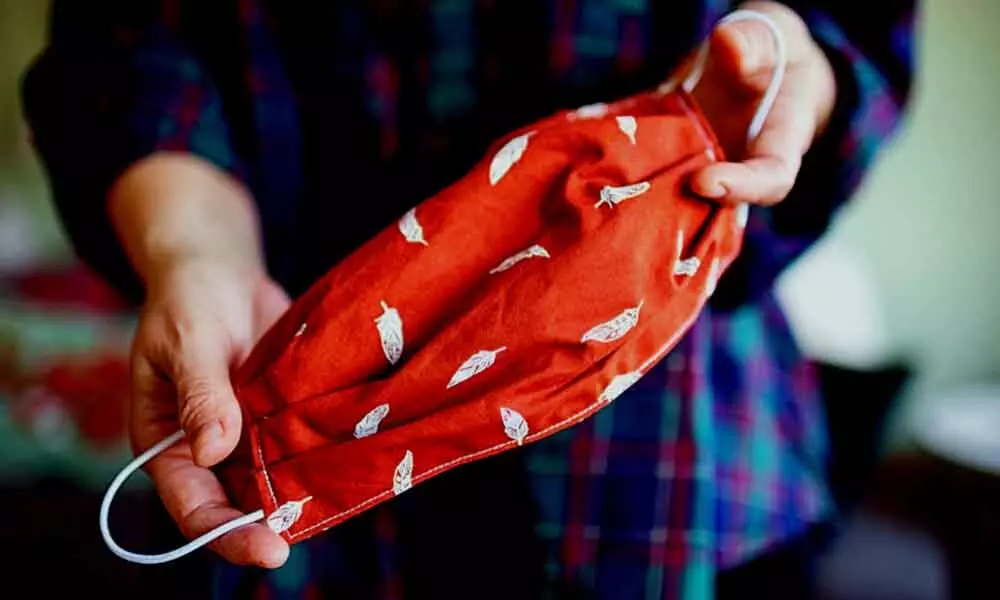Live
- Kareena reveals her favourite Shyam Benegal film featuring sister Karisma
- A day with Collector Jeebanananda Mohanty
- Odisha signs pact to operate hydrogen-powered bus
- I am a victim of chit fund scam too: Majhi
- Telangana’s Ganapathi Self-Help Group Emerges Winner at PepsiCo India’s RevolutioNari Awards 2024
- Karnataka State real estate body faces problems over fine collection from builders
- ‘Mother India’ Shefali Shah goes river rafting in Rishikesh
- Hotlines meant for cybercrimes not going through in Bengaluru
- Police appeals to public to stay alert against ‘digital arrest’ scam
- Coastal enthusiasts rejoice as govt announces funding for Kambala
Just In
Can homemade masks prevent Coronavirus spread when we sneeze?


Can homemade masks prevent Coronavirus spread when we sneeze? (Photo/AP)
Masks made with common household fabrics help prevent the spread of viruses like Covid-19
New York: Masks made with common household fabrics help prevent the spread of viruses like Covid-19 as researchers have found that they are considerably effective at blocking droplets similar to those that may be released by speaking, coughing and sneezing, even as a single layer.
For the study, published in the journal Extreme Mechanics Letters, the researchers examined the effectiveness of common household fabrics that ranged from new and used garments, quilted cloths, bedsheets and dishcloth material in blocking droplets.
Aerosol particles are typically classified as less than five micrometers, and lie in the range of hundreds of nanometers.
However, larger droplets -- up to about one millimetre in diameter -- can also be expelled when an individual speaks, coughs or sneezes.
These larger droplets pose a problem because, with sufficient momentum, they can squeeze through the pores of some fabrics, break into smaller droplets and become airborne.
However, for an individual to feel compelled to wear a mask, it must be comfortable and breathable, the researchers said.
The team tested the breathability and droplet-blocking ability of 11 common household fabrics, using a medical mask as a benchmark.
The researchers then characterised the fabrics in terms of their construction, fiber content, weight, thread count, porosity and water-absorption rate.
"Testing the breathability of these fabrics was the easy part," said Taher Saif, Professor at the University of Illinois, Urbana-Champaign in the US.
"We simply measured the rate of airflow through the fabric. Testing the droplet-blocking ability is a bit more complicated."
In the lab, the researchers fill the nozzle of an inhaler with distilled water seeded with easy-to-find 100-nanometer diameter fluorescent particles -- which happens to be the size of a novel coronavirus particle.
When puffed, the inhaler forces the water through the nozzle and generates high-momentum droplets that collect on a plastic dish placed in front of the inhaler.
To test the fabrics, the researchers repeat this process with the various materials placed over the collection dishes.
"We count the number of nanoparticles landing on the dish using a high-resolution confocal microscope. We can then use the ratio of the number collected with and without the fabric to give us a measure of droplet-blocking efficiency," Saif said.
The team also measured the velocity and size of the particles expelled from the inhaler using high-speed video.
"We found that all of the fabrics tested are considerably effective at blocking the 100 nanometer particles carried by high-velocity droplets similar to those that may be released by speaking, coughing and sneezing, even as a single layer," Saif said.
"With two or three layers, even the more permeable fabrics, such as T-shirt cloth, achieve droplet-blocking efficiency that is similar to that of a medical mask, while still maintaining comparable or better breathability."

© 2024 Hyderabad Media House Limited/The Hans India. All rights reserved. Powered by hocalwire.com






